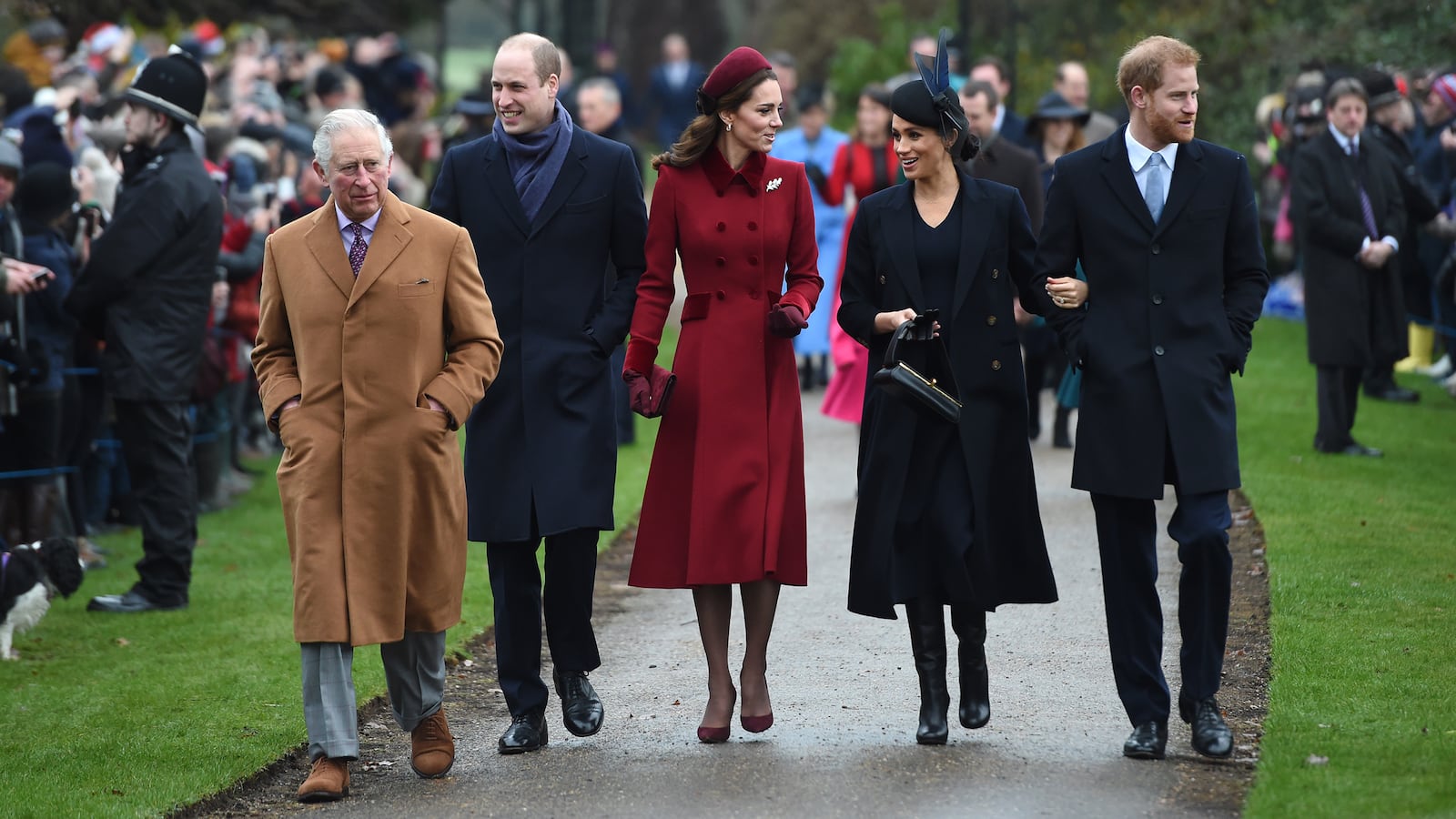One can well imagine the pin-drop silence in which the queen’s words were received in the drawing room of Sandringham House at 3pm on Christmas Day, when Kate and Meghan gathered with other members of the royal family, as is customary, to watch their grandmother-in-law’s annual address to the nation.
“Even with the most deeply held differences, treating the other person with respect and as a fellow human being is always a good first step towards greater understanding,” the queen said, in unusually vague remarks, that have been widely interpreted as a message to the opposing factions in Britain’s Brexit civil war.
But many—and especially, one might imagine, those gathered by the crackling fire at Sandringham—believe the remarks were a coded public intervention into the widely reported quarrels between William and Harry and Meghan and Kate which have dominated royal news this year.
To Her Majesty’s warring grandchildren and their spouses, the message was clear: be nice, and if you can’t be nice, behave.
It was a rather bizarre paragraph for Elizabeth, usually so adept at avoiding controversy, to include in her speech.
Whether she intended it to refer to Meghan and Kate or not, it should have been obvious to her and her advisers that the remarks at least could be taken that way.
And so it proved. The line made it inevitable that the dying embers of the feud narrative—which allegedly began when William apparently told Harry he was unsure if Meghan was a suitable bride for him—made a reappearance in otherwise quiet Christmas Day news feeds.
The festive period has been an important moment of royal branding ever since Victoria and Albert invented Christmas in its modern incarnation, inviting the London News into their beautiful home to sketch them and their kids arrayed around a strange German thing known as a Christmas tree.
But Christmas 2018 has been marred by a succession of entirely preventable blunders, which, between them, mark this year out as one of the less successful Christmases on record for the royals.
The miscalculations began the day after the queen’s London lunch party for her extended family, when, as is her custom, she made her way down to London’s King’s Cross railway station to travel by train to Sandringham.
This train trip is an annual festive tradition. Photographers gather at both ends to snap the queen and her husband as they engage in a charming pastiche of everyday life.
It’s such a reliable staple of the holiday season, as integral to the time of year as plum pudding and holly, that when she and her husband, Prince Philip, failed to arrive at King’s Cross two years ago at short notice, and it was subsequently revealed they were suffering a ‘heavy cold’, obituaries of Elizabeth and her then-95 year old consort were hastily dusted down.
Philip is now 97, and although the queen appeared at the train as planned, Philip was a no-show again this year, setting off another minor panic as newspapers updated their assessments of Philip’s life and times.
It’s an understandably sensitive subject, but the latter stretch of Philip’s life is not being handled well by the palace. Unnecessary drama is being caused by not definitively ruling him out of all public appearances entirely, which, a case can now be made, they should have done when he officially retired last autumn.
The problem arose again on Christmas Day, when Philip failed to appear at St Mary’s Church in Sandringham.
There had been no briefings that he wasn’t going to attend, so Philip’s no-show was a shock, and genuine news.
Despite the fact that he has only ever missed church on Christmas Day once before the palace gamely affected a tone of minor outrage when reporters questioned if ill-health was behind the nonagenarian’s non-appearance, with an official source telling Reuters: “The duke is in perfectly good health, he is just spending the day privately.”
Of course, he may have been as bright as a button and have simply decided not to go to church for only the second time ever, but skepticism on that score would be justified. If he really didn’t want to go despite being in top form, the palace should have briefed the media about that decision several days in advance, so it wasn’t a shock.
As it was, questions about Philip’s health came close to capsizing the day’s intended narrative; the Cambridges and the Sussexes playing nice, striding into church side by side, in perfect harmony.
Even this didn’t work brilliantly. The bonhomie looked a bit forced and staged, and there seems little reason to doubt a report in The Sun, in which a source said that both couples were under orders and that the show of togetherness was “awkward and uncomfortable given what's gone on over the past 12 months.”
The source told The Sun: “The queen and Charles have made it clear that Christmas was for the whole family to really come together. That meant the two couples walking into church together as the Fab Four, just like they had last year.”
The message of peace and reconciliation was supposed to be central to the speech, but again it got overwhelmed by the possible references to the feud and, bizarrely, an extraordinary row over a gold piano in the backdrop.
While many fans of royal maximalism adored the glamor of the piano—an heirloom from the era of Victoria and Albert—critics felt the display of opulence was ill-suited to a national mood of Brexit-anxiety and economic contraction, and clashed with the queen’s all-pull-together message.
It certainly felt tonally jarring to see the queen eschewing her usual Tupperware-on-the-table policy of being seen to do nothing that could be construed as elitist.
All the signs, anyway, are that a major rethink of the Christmas address is long overdue. It’s still the biggest ratings draw on TV on Christmas Day, but only just. Audiences for the queen’s speech reached a peak in the late 1980s, with 28 million watching in 1987.
Last year it was 7.5 million, but this year just 6.3 million viewers tuned in to watch the queen perched in front of her gold piano at 3pm.
But the royal family as an institution is slow to learn, and this was made abundantly clear by the fact that on Boxing Day (as the 26 December is known) the royals wandered out into the muddy fields of Sandringham armed with shotguns and blasted to death hundreds of birds specially reared for that purpose at great expense, in their annual Christmas shoot.
The fact that Meghan ‘allowed’ Harry to participate despite her previously well-publicized anti-animal cruelty credentials was offered up as evidence of just how keen she is to ‘fit in’ with the family’s ways.
But there’s no good optics for the royals in killing animals for fun.
Of course, a case could be made that this was not the year for Meghan and Harry to rock the boat, and maybe going on the shoot was the least-bad option if internal family politics are taken into account.
But before Meghan gets completely swallowed up by the culture of the powerful family she has joined, let’s hope she is able to help her husband see the bigger picture on this issue next year.
Getting Harry to put his guns down really might be worth one more argument with the in-laws.







